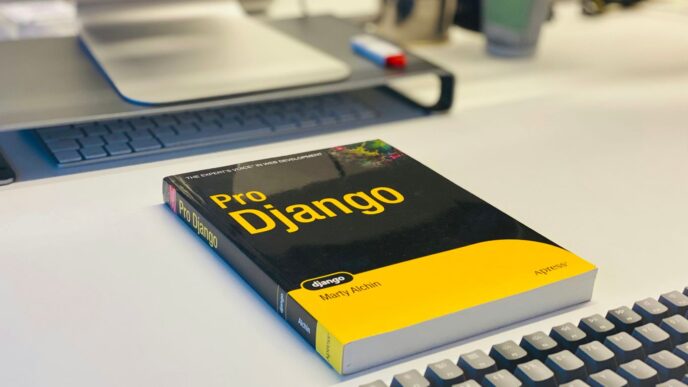So, you want to get good at LeetCode, especially using Java? It’s a common goal for a lot of us trying to land those tech jobs. This guide is all about helping you get there. We’ll go over how to tackle problems, make your code run faster, and just generally get better at solving coding challenges. Think of it as a friendly chat about getting ready for interviews and making your Java skills shine.
Key Takeaways
- Understand the basics of data structures and algorithms.
- Learn to use Java’s built-in tools for better code.
- Always think about how fast your code runs and how much memory it uses.
- Practice a lot, especially with common problem types.
- Get comfortable with mock interviews to build confidence.
Foundational LeetCode Solutions in Java
Core Data Structures for LeetCode Solutions Java
Okay, so when you’re starting out with LeetCode in Java, you really need to nail down the basics. I mean, you can’t build a house without a solid foundation, right? Same deal here. We’re talking about data structures. These are the building blocks you’ll use to solve pretty much every problem. Think of them as your toolbox. You’ve got your arrays, which are super useful for storing a bunch of elements of the same type. Then there are linked lists, which are more flexible than arrays because you can easily add or remove elements. Hash tables (or HashMaps in Java) are amazing for quick lookups. Stacks and queues are also important, especially for certain types of problems. And don’t forget about trees, especially binary trees, which pop up all the time. Mastering these core data structures is absolutely key.
Here’s a quick rundown:
- Arrays: Ordered collection of elements. Great for direct access.
- Linked Lists: Sequence of nodes, each pointing to the next. Good for insertions and deletions.
- Hash Tables (HashMaps): Key-value pairs for fast lookups. Super useful!
- Stacks: Last-in, first-out (LIFO) data structure.
- Queues: First-in, first-out (FIFO) data structure.
- Trees (Binary Trees): Hierarchical data structure. Used in many algorithms.
Essential Algorithms for LeetCode Solutions Java
Alright, so you’ve got your data structures down. Now it’s time to learn some algorithms. Algorithms are basically step-by-step procedures for solving problems. Some of the most important ones for LeetCode include sorting algorithms (like quicksort, mergesort, and heapsort), searching algorithms (like binary search), and graph traversal algorithms (like depth-first search and breadth-first search). You should also get familiar with recursion and dynamic programming. Dynamic programming can be tricky, but it’s super powerful for solving optimization problems. Understanding time and space complexity is also important, so you can write efficient code.
Here’s a quick list of algorithms to focus on:
- Sorting Algorithms: Quicksort, Mergesort, Heapsort. Know their time complexities!
- Searching Algorithms: Binary Search. Essential for sorted data.
- Graph Traversal: DFS, BFS. Important for graph-related problems.
- Recursion: Solving a problem by breaking it down into smaller subproblems.
- Dynamic Programming: Solving optimization problems by storing solutions to subproblems.
Optimizing Brute-Force Approaches in LeetCode Solutions Java
Okay, so you’ve got a problem, and the first thing that comes to mind is a brute-force solution. That’s totally fine! Sometimes, it’s good to just get something working, even if it’s not the most efficient thing in the world. But on LeetCode, you often need to optimize your code to pass all the test cases. So, how do you do that? Well, one thing you can do is look for ways to reduce the number of operations your code performs. For example, if you’re using nested loops, can you find a way to avoid one of the loops? Can you use a hash table to speed up lookups? Can you use dynamic programming to avoid recomputing the same values over and over again? The key is to identify the bottlenecks in your code and find ways to eliminate them. Also, think about the data structures you’re using. Are you using the most appropriate data structure for the task at hand? Sometimes, switching to a different data structure can make a big difference in performance.
Here are some optimization techniques:
- Reduce Unnecessary Operations: Look for redundant calculations.
- Use Hash Tables: For faster lookups.
- Apply Dynamic Programming: To avoid recomputation.
- Choose the Right Data Structure: The right tool for the job!
- Consider Space-Time Tradeoffs: Sometimes, using more memory can speed up your code.
Advanced LeetCode Solutions with Java Features
Leveraging Java’s Collections Framework for LeetCode Solutions
Okay, so you’re trying to up your LeetCode game with Java? One of the best ways to do that is to really get to know the Collections Framework. It’s not just about using ArrayList and HashMap – it’s about understanding when to use them, and how to use them well.
For example, I was struggling with a problem involving finding the most frequent element in a stream of data. My initial approach was a mess of nested loops and manual counting. Then I remembered the HashMap and its getOrDefault() method. Suddenly, the code became way cleaner and faster. It’s those little things that make a big difference.
Here’s a few things to keep in mind:
HashMapfor fast lookups: Great for problems where you need to quickly check if an element exists or count its occurrences. Think of problems like "Two Sum" or "Group Anagrams." Using a HashMap for LeetCode can drastically improve performance.HashSetfor uniqueness: Perfect for removing duplicates or checking if an element is already present. Useful in problems like "Longest Substring Without Repeating Characters."PriorityQueuefor sorting on the fly: This is your go-to when you need to maintain a sorted collection while adding or removing elements. It shines in problems like "Kth Largest Element in a Stream."
Mastering the Java Stream API for Efficient LeetCode Solutions
The Java Stream API… at first, it looks kinda intimidating, right? All those map(), filter(), and reduce() calls can seem confusing. But trust me, once you get the hang of it, it can seriously clean up your code and make it more readable. Plus, it can sometimes lead to performance improvements, especially when dealing with large datasets. The Stream API allows you to process collections of data in a declarative way, which can make your code more concise and easier to understand.
I remember one time I was working on a LeetCode problem that involved filtering a list of numbers and then calculating their sum. My initial solution was a bunch of for loops and if statements. It was ugly and hard to read. Then I rewrote it using the Stream API, and it became a one-liner! It was like magic.
Here’s a simple example:
List<Integer> numbers = Arrays.asList(1, 2, 3, 4, 5, 6);
int sumOfEvenSquares = numbers.stream()
.filter(n -> n % 2 == 0)
.map(n -> n * n)
.reduce(0, Integer::sum);
See how clean that is? No more manual iteration, no more temporary variables. The Stream API handles all the heavy lifting for you. Just remember to use it wisely. Sometimes, a simple for loop is still the best option, especially when performance is critical.
Applying Recursion and Iteration in LeetCode Solutions Java
Recursion and iteration are two sides of the same coin, really. Both let you repeat a process, but they do it in different ways. Recursion is all about breaking a problem down into smaller, self-similar subproblems. Iteration, on the other hand, is about repeating a set of instructions until a condition is met. Knowing when to use each one is key to writing efficient and elegant LeetCode solutions. For LeetCode practice, understanding both approaches is important.
I used to be scared of recursion. It seemed like some kind of black magic that I didn’t understand. But then I realized that it’s just a way of thinking about problems. Once you get the hang of it, it can be incredibly powerful. Think about problems like tree traversals or graph searches. Recursion is often the most natural way to solve these types of problems.
But recursion isn’t always the best option. It can be inefficient, especially if the recursion depth is large. This is because each recursive call adds a new frame to the call stack, which can consume a lot of memory. In these cases, iteration is often a better choice. Iteration is generally more efficient because it doesn’t involve the overhead of function calls.
Here’s a quick comparison:
| Feature | Recursion | Iteration |
|---|---|---|
| Memory Usage | Higher (due to call stack) | Lower |
| Performance | Can be slower (due to function calls) | Generally faster |
| Readability | Can be more elegant for certain problems | Can be more verbose but easier to follow |
| Problem Types | Tree traversals, graph searches, etc. | Array processing, list manipulation, etc. |
Performance Optimization for LeetCode Solutions Java
Analyzing Time and Space Complexity in LeetCode Solutions Java
Okay, so you’ve got a solution that works. Great! But does it work well? That’s where time and space complexity come in. Understanding these concepts is absolutely key to writing efficient code. It’s not just about getting the right answer; it’s about getting the right answer in a reasonable amount of time and without using up a ton of memory. I remember one time I wrote a solution that worked perfectly for small inputs, but when I tried it on a larger dataset, it took forever. Turns out, my algorithm had a terrible time complexity. Let’s avoid that, shall we?
- Big O notation is your friend. Learn it, love it, live it.
- Consider the trade-offs between time and space. Sometimes, you can speed things up by using more memory, and vice versa.
- Practice analyzing the complexity of your code. The more you do it, the easier it becomes.
Techniques for Optimizing LeetCode Solutions Java
So, you know your code is slow or uses too much memory. Now what? Well, there are a bunch of techniques you can use to optimize it. One of the most common is to use the right data structure. For example, if you need to look up values quickly, a HashMap is usually a better choice than a List. Another technique is to avoid unnecessary calculations. If you’re doing the same calculation multiple times, store the result in a variable and reuse it. And don’t forget about algorithmic improvements! Sometimes, a simple change to your algorithm can make a huge difference. For example, using two pointers can often reduce the time complexity of your solution. I once spent hours trying to optimize a brute-force solution, only to realize that a completely different algorithm was much more efficient. Here’s a few things to keep in mind:
- Use appropriate data structures (HashMap, HashSet, etc.)
- Minimize redundant calculations.
- Consider alternative algorithms.
Avoiding Common Performance Pitfalls in LeetCode Solutions Java
There are some common mistakes that can really hurt the performance of your Java code. One is using recursion when iteration would be more efficient. Recursion can be elegant, but it can also lead to stack overflow errors if you’re not careful. Another pitfall is creating too many objects. Object creation can be expensive, so try to reuse objects whenever possible. And be careful about using strings. Strings are immutable in Java, so concatenating them repeatedly can create a lot of garbage. Use a StringBuilder instead. I’ve seen so many people fall into these traps, including myself! It’s all part of the learning process. To avoid these issues, remember:
- Avoid excessive recursion.
- Minimize object creation.
- Use
StringBuilderfor string manipulation.
Here’s a quick table summarizing some common performance pitfalls and how to avoid them:
| Pitfall | Solution |
|---|---|
| Excessive Recursion | Use iteration or memoization. |
| Too Many Object Creations | Reuse objects or use object pools. |
| String Concatenation | Use StringBuilder. |
| Inefficient Data Structures | Choose the right data structure for the job. |
Strategic Problem-Solving for LeetCode Solutions Java
Developing a Problem-Solving Mindset for LeetCode Solutions Java
It’s easy to get bogged down in the details of code, but cultivating the right mindset is key. Think of each LeetCode problem as a puzzle. Don’t just jump into coding; take a moment to really understand the problem. What are the constraints? What’s the expected input and output? Can you break the problem down into smaller, more manageable parts? A good problem-solving mindset involves:
- Understanding the problem fully before coding.
- Considering different approaches and their trade-offs.
- Being comfortable with ambiguity and incomplete information.
- Learning from mistakes and iterating on solutions.
Practicing High-Frequency LeetCode Solutions Java Problems
Some problems show up again and again in interviews. It makes sense to focus on these. It’s not about memorizing solutions, but about recognizing patterns and applying the right techniques. Some high-frequency problems involve core data structures like arrays, linked lists, and trees. Others focus on common algorithmic patterns like dynamic programming or graph traversal. Here’s a rough breakdown of how to prioritize your practice:
- Arrays and Strings: These are fundamental and appear in many variations.
- Linked Lists: Practice insertion, deletion, and reversal.
- Trees and Graphs: Master traversal algorithms like BFS and DFS.
Reviewing and Refining LeetCode Solutions in Java
Solving a problem once isn’t enough. The real learning comes from reviewing your solution and looking for ways to improve it. Can you make it more efficient? Is your code readable and well-documented? Can you think of alternative approaches? Reviewing and refining your solutions helps solidify your understanding and prepares you for more complex problems. Consider these steps:
- Analyze the time and space complexity of your solution.
- Compare your solution to others and identify areas for improvement.
- Refactor your code for readability and maintainability.
- Document your code with clear and concise comments. Consistent LeetCode practice is the best way to improve.
Interview Preparation with LeetCode Solutions Java
Structuring Your LeetCode Solutions Java Practice Routine
Okay, so you’re gearing up for those tech interviews, huh? Let’s talk about setting up a solid LeetCode practice routine. It’s not just about grinding problems; it’s about being smart about it. Consistency is key here.
Think of it like this:
- Start with the fundamentals: Don’t jump into the hard stuff right away. Get comfortable with basic data structures and algorithms. Work through problems involving arrays, linked lists, trees, and graphs. This builds a strong base. You can start with core data structures and algorithms algorithms.
- Allocate specific time slots: Treat your LeetCode practice like a class or a meeting. Schedule it in your calendar and stick to it. Even 30 minutes a day is better than nothing.
- Mix it up: Don’t just focus on one type of problem. Alternate between different categories to keep your mind sharp and avoid burnout. Try to solve LeetCode problems LeetCode practice efficiently.
Simulating Mock Interviews for LeetCode Solutions Java
Alright, you’ve been practicing, but can you perform under pressure? Mock interviews are where it’s at. It’s like a dress rehearsal for the real thing.
Here’s the deal:
- Find a friend (or a mentor): Ask someone to play the role of the interviewer. It could be a classmate, a colleague, or even a former interviewer. Having someone else there adds a layer of realism. You can also incorporate mock interviews mock interviews into your routine.
- Set the stage: Mimic the actual interview environment as closely as possible. Use a whiteboard or online coding platform. Time yourself and stick to the time limits.
- Get feedback: After the mock interview, ask for honest feedback. What did you do well? Where could you improve? Pay attention to both your technical skills and your communication skills.
Building Confidence with LeetCode Solutions Java
Confidence is a huge part of acing those interviews. If you don’t believe in yourself, it’s going to show. So, how do you build that confidence?
- Track your progress: Keep a record of the problems you’ve solved. Seeing your progress over time can be a great motivator. Celebrate small wins along the way.
- Focus on understanding, not memorization: Don’t just memorize solutions. Understand the underlying concepts and be able to explain them clearly. This will help you adapt to new problems and think on your feet. Mastering efficient problem-solving techniques is key.
- Practice explaining your solutions out loud: This is super important. You need to be able to articulate your thought process clearly and concisely. Practice with a friend or record yourself. It might feel awkward at first, but it’s worth it. You can crack LeetCode problems crack LeetCode problems efficiently by practicing consistently.
Common LeetCode Solutions Patterns in Java
Implementing Two Pointers for LeetCode Solutions Java
Okay, so the Two Pointers pattern is something I use all the time on LeetCode. It’s super useful for problems involving arrays or linked lists where you need to compare elements or find a specific pair. Basically, you have two pointers (indices) that move through the data structure, usually from opposite ends or from the same start point, depending on the problem. It’s way more efficient than brute-force because you’re not always doing nested loops. I remember one time I was trying to solve a problem involving finding pairs that sum to a target value, and the Two Pointers approach turned my code from a time-limit-exceeded mess into a blazing-fast solution. It’s all about strategically moving those pointers!
Dynamic Programming Approaches in LeetCode Solutions Java
Dynamic Programming (DP) can be intimidating, but once you get the hang of it, it’s like unlocking a superpower. It’s all about breaking down a big problem into smaller, overlapping subproblems, solving those once, and storing the results to avoid recomputation. I usually start by trying to write a recursive solution, and then I see if I can optimize it with memoization (top-down DP) or tabulation (bottom-up DP). Tabulation often involves building a table (array or matrix) to store the solutions to the subproblems. For example, the classic Fibonacci sequence problem is a perfect candidate for DP. Here’s a quick comparison:
| Approach | Description | Pros | Cons |
|---|---|---|---|
| Recursion | Solve by breaking down into smaller instances of the same problem. | Simple to understand. | Can be very slow due to repeated calculations. |
| Memoization | Top-down approach; store results of expensive function calls and reuse them. | Faster than plain recursion; avoids redundant calculations. | Can still hit stack overflow errors for very deep recursion. |
| Tabulation | Bottom-up approach; build a table of results from the smallest subproblems. | Most efficient; avoids recursion and stack overflow issues. | Can sometimes be less intuitive to implement than recursion or memoization. |
Graph Traversal Techniques for LeetCode Solutions Java
Graphs are everywhere in LeetCode, and knowing how to traverse them is key. Depth-First Search (DFS) and Breadth-First Search (BFS) are the two main algorithms. DFS is great for exploring as far as possible along each branch before backtracking, while BFS is perfect for finding the shortest path between two nodes. I often use DFS for problems like finding connected components or detecting cycles, and BFS for problems like finding the shortest distance in an unweighted graph. Here are some common graph representations:
- Adjacency Matrix: A 2D array where
matrix[i][j]indicates if there’s an edge between nodeiand nodej. - Adjacency List: An array of lists, where each list
adj[i]contains the neighbors of nodei. - Edge List: A list of tuples, where each tuple
(u, v)represents an edge between nodeuand nodev.
When I’m working with graphs, I always make sure to keep track of visited nodes to avoid infinite loops. Using a HashSet to store visited nodes is a lifesaver. Also, understanding the time and space complexity of DFS and BFS is important for optimizing your solutions. DFS usually has a space complexity of O(V) in the worst case (where V is the number of vertices), while BFS can have a space complexity of O(V + E) (where E is the number of edges) in the worst case.
Wrapping Things Up
So, that’s pretty much it. Getting good at LeetCode with Java isn’t some magic trick; it’s just about putting in the time. You gotta practice, keep learning, and not get too bummed out when a problem stumps you. Every little bit of effort you put in helps you get better at solving problems and writing cleaner code. Stick with it, and you’ll definitely see yourself improve. Good luck out there!
Frequently Asked Questions
Why is it important to learn LeetCode solutions using Java?
Getting good at LeetCode in Java means you’ll be much better at solving coding problems, which is super important for getting a good job in tech. It helps you think clearly, write good code, and understand how to make your programs run fast and use less memory.
What basic things should I know before starting LeetCode in Java?
You should definitely know about common data structures like arrays, lists, maps (HashMaps), and trees. Also, get familiar with basic algorithms such as sorting, searching, and how to use loops and recursion. These are the building blocks for almost all problems.
How should I begin practicing LeetCode problems?
Start with the easy problems to get comfortable. Then, slowly move to medium and hard ones. It’s like learning to walk before you run! Focus on understanding the problem first, then try to solve it in a simple way, and finally, try to make your solution better.
How can Java’s special features help me with LeetCode?
Java has some really helpful built-in tools like ArrayLists, HashMaps, and the Stream API. Using these can make your code shorter and often faster. Knowing when and how to use them well is a big advantage.
Why is it important to think about how fast my code runs and how much memory it uses?
It’s super important to figure out how fast your code runs (time complexity) and how much memory it uses (space complexity). This helps you see if your solution is good enough or if it needs to be improved. Always try to make your code more efficient.
What’s the best way to get ready for coding interviews using LeetCode and Java?
The best way is to practice regularly, even if it’s just a little bit each day. Try to solve problems without looking at the answers right away. Also, pretend you’re in a real interview and try to solve problems under time pressure. This builds confidence and helps you think on your feet.














